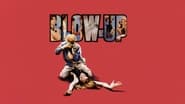Richard Harvey
Meteorically successful society photographer goes about his work in Swinging Sixties London. While scouting further shots for his forthcoming book he chances on and photographs an ostensibly romantic couple in a park. The woman notices, but her vehement demand for the negatives is denied. Back at his fashion studio, progressive enlargement of the images seems to reveal a murder, made more mysterious by the urgent re-appearance of the woman (who has followed him) and her renewed pleas. Our hero returns to the park at night, and finds a body in the location suggested by his photographs. Meanwhile, his studio has been ransacked, and nearly all the photographs stolen. Early the next morning he returns, finding the corpse vanished. While in the park, he watches a group of young people play a make-believe game of tennis. At first only slightly amused, he finds himself joining in. At that moment he too vanishes, and the film, which covers only a 24-hour period, ends.So much for the nominal plot. When I first saw it in 1967, I was only impressed by its modern decadence. The many subsequent viewings have however revealed an extending layered interest. Part of that must be nostalgia, for whatever the fashion insiders of the time say, it paints a thoroughly vivid picture of how London life felt and was perceived in that period.It appears to be generally accepted that Carlo Ponti withdrew funding for this the first Antonioni film made both in colour and in English when it ran extravagantly over-budget, with the crew sent back to Italy and Antonioni told to make the film from the footage already in the can. Ronan Casey, playing the corpse, says there was an extended murder plot involving Sarah Miles, Vanessa Redgrave and her lover, (Jeremy Glover) (except for Reg, Ron and Bill, the conduits of photographic and painted images, none of the characters has a name in the film, although they do in the script). This version of events is supported by Redgrave and Glover's appearance in the film in unexplained circumstances (Glover spying on the hero in the restaurant, and both in a Rover 2000 following the photographer's car). Of course, that does not mean that, as edited, the 'full' film would have amounted to no more than a conventional murder mystery.At least three main threads interweave (apart from the ideas of image and reality which have been extensively addressed by others). The first is the character of the hero. The young protagonist has found extreme success early, most youthful ambitions already satisfied. Beautiful and naked girls, treated as no more than the foot soldiers of the fashion industry, throw themselves at him. Ennui has set in ("I'm off London this week" – "If I was rich I would be free") and he seems bored by a (then) outrageous society marijuana party, and by a Yardbirds performance. He has already seen through, but not wholly rejected, the excesses of 60s culture. Although often off-hand and abrupt, sometimes arrogant, he is searching for a worthwhile commitment, for meaning and for value and is open to ideas. Thus, his luxurious Rolls Royce is always, rain or shine, open-topped (unusual in England), he donates to rag-week collectors/student protesters (an important feature of the 1960s) with a smile, and accommodates their anarchic rejection placard ("Go Away"), again with amusement. He tries to find serious meaning in his disguised and gritty doss-house photography but perhaps it only adds up to a business opportunity. He is interested in an antique- shop, but only in the end for redevelopment potential. He describes a non-beautiful wife, easy to live with, and children, but then denies their existence, perhaps because they are simply his present ideal. The possible murder represents the first glimmer of challenge to his humanity. When this fails, he is drawn into the tennis-game, and becomes one with both reality and disappearance (unreality), when he makes himself complicit in the group fantasy.The second layer consists of the language of cinematography. The colour and framing are stylised, stylish as well as realistic. Camera and protagonist viewpoints sometimes do not coincide, in a way that is non-neutral, giving the camera a narrative function. Most important is the highly original sound design. Long takes of only ambient noise (not silence- with audible planes overhead, road-drills, ice-cream vans) including of course the famous wind in the trees. There is no background music (except extra-diegetically over credits). All other sound, including music, is strictly diegetic – we are always shewn the radio, the spinning gramophone record, the switching on and off. The tennis match is not in fact silent – we hear footsteps, and the wind – the noise of a mimed performance. We then hear, but do not see, ball on racquet, the only non-diagetic moment in the film. Simon and Garfunkel's Sound of Silence reached Nr 1 in the US in January 1966. Possibly Antonioni had this in mind – the reference to neon gods perhaps the inspiration for the scaffolded neon tower he built behind Maryon Park. The invisible sounds are almost the most real features of the film.The third thread is the symbolism. In most indoor locations in the film there is a bust – perhaps life and death, history, or another, 3D, type of image. The occasional child – the hero particularly looks at the child each time. Communication: the white telephone in the studio, the red telephone in the street, the blue radio-telephone in the car (Blue 439). Maryon Park is green, and the photographer wears a green jacket. But the park is surrounded by urban life (Antonioni built the neon tower and the white gable-ends to emphasize this point), so it is only nominally wild, natural or real, or perhaps an oasis (as well as the Kennedy grassy-knoll and the staple location for Cold-War spy-thrillers). The students, a linking theme, are also a Greek chorus, commenting on the search for truth, meaning and value.



